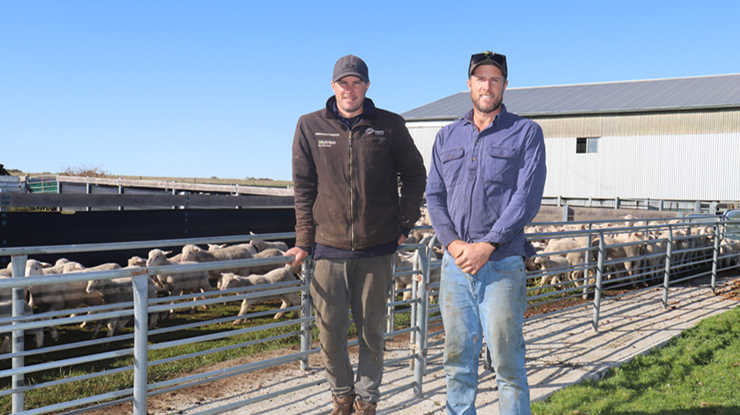 Sheep and cattle producers, Tim and David Pyle
Sheep and cattle producers, Tim and David Pyle
Brassica earns its place to fatten lamb
Key points
- Being part of the PDS allowed the Tim and David Pyle to see industry best practice and introduced them to new concepts and practices.
- Soil preparation and adequate summer rainfall are the most critical factors to ensuring the forage crops succeed.
- They are so convinced of the value of summer forages for their enterprise, the Pyles now regularly set aside some of their better paddocks for them.
Brothers Tim and David Pyle put forage crops through their paces as a feed option in their mixed farming enterprise on the south coast of WA.
In 2020, they took part in an MLA-supported project to explore the value of alternate summer forage crops for liveweight gain in their lambs.
The region has warm, dry summers and autumns. Prior to the project, the Pyles were supplementing their lambs in the first four to five months with dry feed.
The Pyles opted for the brassica Pallaton Raphno®, a kale–radish hybrid, to compare with their existing canola stubble and ryegrass pasture.
Dry matter cuts prior to grazing showed the Raphno® had more biomass available (3.83t/ha compared to 3.01 t/ha for ryegrass).
Nutrient value analysis revealed the Raphno® to be of much higher feed quality:
- crude protein – as % of dry matter (DM) – was more than double at 16.4 compared to 7.9 for ryegrass
- digestibility (% of DM) was 88.3 compared to 51.2
- metabolisable energy (MJ/kg of DM) was 13.6 compared to 7.2 for ryegrass.
Stocking rates
The Pyles grazed 30ha of ryegrass with 360 lambs at a stocking rate of 12/ha, while 45ha of RaphnoR was grazed with 1,400 lambs at a rate of 31.11/ha.
Taking the different stocking rates into account, the RaphnoR® produced excellent results.
The lambs grazed on the Raphno® gained an extra 62.5g/head/day – 171.88g compared to 109.38g for the lambs on ryegrass. This equated to an average weight gain of 5.35kg/ha/day for the Raphno®, compared to 1.31kg/ha/day for ryegrass.
In the second year, the alternate forage was compared to canola stubble (with germinated clover) with 59ha of Raphno® grazed with 1,580 lambs and 30ha of canola stubble grazed with 670 lambs.
Conditions were vastly different to the first year, with the crop receiving very little rain. Despite this, at the end of the grazing period in the second year, there was still significant biomass in the paddock.
Tim said soil preparation and adequate summer rainfall are the most critical factors to ensuring the forage crops succeed. He also said it was important to have appropriate inputs ready when they were needed.
“It’s not having weeds which will compete with the plants as they germinate,” Tim said. “It’s having the nitrogen ready when you’re about to get rain, and it’s being prepared to spray for diamondback moth as soon as you see it.”
As a result of their participation in the trial, Tim said they will now always plant summer crops.
Over the past two years they have changed from Raphno® to Hyola 970CL to reduce costs.
Because they are so convinced of the value of summer forages for their enterprise, the Pyles now regularly set aside some of their better paddocks for them.
“It allows us to reduce our reliance on grain to finish our lambs,” Tim said.
“We still have our grain-fed operation but if the crops go well, we don’t need to spend anywhere near as much money on the lambs to finish them. It’s an extremely cheap way of fattening lambs.”



